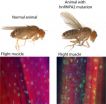(Press-News.org) NEW YORK (March 3, 2013) -- The powerful master regulatory transcription factor called Bcl6 is key to the survival of a majority of aggressive lymphomas, which arise from the B-cells of the immune system. The protein has long been considered too complex to target with a drug since it is also crucial to the healthy functioning of many immune cells in the body, not just B cells gone bad.
But now, in the journal Nature Immunology, researchers at Weill Cornell Medical College report that it is possible to shut down Bcl6 in the cancer, known as diffuse large B-cell lymphoma (DLBCL), while not affecting its vital function in T cells and macrophages that are needed to support a healthy immune system.
"The finding comes as a very welcome surprise," says the study's lead investigator, Dr. Ari Melnick, Gebroe Family Professor of Hematology/Oncology and director of the Raymond and Beverly Sackler Center for Biomedical and Physical Sciences at Weill Cornell.
"This means the drugs we have developed against Bcl6 are more likely to be significantly less toxic and safer for patients with this cancer than we realized," says Dr. Melnick, who is also a hematologist-oncologist at NewYork-Presbyterian Hospital/Weill Cornell Medical Center.
If Bcl6 is completely inhibited, patients might suffer from systemic inflammation and atherosclerosis. Weill Cornell researchers conducted this new study to help clarify possible risks, as well as to understand how Bcl6 controls the various aspects of the immune system.
DLBCL is the most common subtype of non-Hodgkin lymphoma -- the seventh most frequently diagnosed cancer -- and many of these patients are resistant to currently available treatments.
"Scientists have been searching for the right answer to treat this difficult lymphoma, which, after initial treatment, can be at high risk of relapse and resistant to current therapies," Dr. Melnick says. "Believing that Bcl6 could not be targeted, some researchers have been testing alternative therapeutic approaches. This study strongly supports the notion of using Bcl6-targeting drugs."
In fact, the findings in this study were inspired from preclinical testing of two Bcl6-targeting agents that Dr. Melnick and his Weill Cornell colleagues have developed to treat DLBCLs. These experimental drugs are RI-BPI, a peptide mimic, and the small molecule agent 79-6.
Dr. Melnick says the discovery that a master regulatory transcription factor can be targeted offers implications beyond just treating DLBCL. Recent studies from Dr. Melnick and others have revealed that Bcl6 plays a key role in the most aggressive forms of acute leukemia, as well as certain solid tumors.
Transcription factors are responsible for either inhibiting or promoting the expression of genes, and master regulatory transcription factors are the equivalent of the CPU of a computer – their actions regulate thousands of genes in different kinds of cells. For example, Bcl6 can control the type of immune cell that develops in the bone marrow -- playing many roles in the development of B cells, T cells, macrophages and other cells -- including a primary and essential role in enabling B-cells to generate specific antibodies against pathogens.
"When cells lose control of Bcl6, lymphomas develop in the immune system. Lymphomas are 'addicted' to Bcl6, and therefore Bcl6 inhibitors powerfully and quickly destroy lymphoma cells," Dr. Melnick says.
The big surprise in the current study is that rather than functioning as a single molecular machine, Bcl6 instead seems to function more like a Swiss Army knife, using different tools to control different cell types. This multi-function paradigm could represent a general model for the functioning of other master regulatory transcription factors.
"In this analogy, the Swiss Army knife, or transcription factor, keeps most of its tools folded, opening only the one it needs in any given cell type," Dr. Melnick says. "For B cells, it might open and use the knife tool; for T cells, the cork screw; for macrophages, the scissors. The amazing thing from a medical standpoint is that this means that you only need to prevent the master regulator from using certain tools to treat cancer. You don't need to eliminate the whole knife," he says. "In fact, we show that taking out the whole knife is harmful since the transcription factor has many other vital functions that other cells in the body need."
Prior to these study results, it was not known that a master regulator could separate its functions so precisely.
"Now we know we can take out a specific tool -- to shut down a specific part of the protein -- that causes the disease we want to treat."
Researchers hope this will be a major benefit to the treatment of DLBCL and perhaps other disorders that are influenced by Bcl6 and other master regulatory transcription factors.
###Study co-authors include Dr. Chuanxin Huang and Dr. Katerina Chatzi from the Division of Hematology and Oncology at Weil Cornell Medical College.
The research was funded by grants from the National Cancer Institute, The Burroughs Wellcome Foundation and the Chemotherapy Foundation. The research was initially supported by a March of Dimes Scholar Award and facilitated by the Sackler Center for Biomedical and Physical Sciences at Weill Cornell.
The Raymond and Beverly Sackler Center for Biomedical and Physical Sciences
The Raymond and Beverly Sackler Center for Biomedical and Physical Sciences of Weill Cornell Medical College brings together a multidisciplinary team of scientists for the purpose of catalyzing major advances in medicine. By harnessing the combined power of experimental approaches rooted in the physical and biological sciences, Sackler Center investigators can best accelerate the pace of discovery and translate these findings for the benefit of patients with various medical conditions, including but not limited to cancer.
Weill Cornell Medical College
Weill Cornell Medical College, Cornell University's medical school located in New York City, is committed to excellence in research, teaching, patient care and the advancement of the art and science of medicine, locally, nationally and globally. Physicians and scientists of Weill Cornell Medical College are engaged in cutting-edge research from bench to bedside, aimed at unlocking mysteries of the human body in health and sickness and toward developing new treatments and prevention strategies. In its commitment to global health and education, Weill Cornell has a strong presence in places such as Qatar, Tanzania, Haiti, Brazil, Austria and Turkey. Through the historic Weill Cornell Medical College in Qatar, the Medical College is the first in the U.S. to offer its M.D. degree overseas. Weill Cornell is the birthplace of many medical advances -- including the development of the Pap test for cervical cancer, the synthesis of penicillin, the first successful embryo-biopsy pregnancy and birth in the U.S., the first clinical trial of gene therapy for Parkinson's disease, and most recently, the world's first successful use of deep brain stimulation to treat a minimally conscious brain-injured patient. Weill Cornell Medical College is affiliated with NewYork-Presbyterian Hospital, where its faculty provides comprehensive patient care at NewYork-Presbyterian Hospital/Weill Cornell Medical Center. The Medical College is also affiliated with the Methodist Hospital in Houston. For more information, visit weill.cornell.edu.
Researchers discover how to shutdown cancer's powerful master protein
Weill Cornell research offers patients hope for new treatments for an aggressive and common lymphoma
2013-03-04
ELSE PRESS RELEASES FROM THIS DATE:
7 genetic risk factors found to be associated with common eye disorder
2013-03-04
An international group of researchers has discovered seven new regions of the human genome—called loci—that are associated with increased risk of age-related macular degeneration (AMD), a leading cause of blindness. The AMD Gene Consortium, a network of international investigators representing 18 research groups, also confirmed 12 loci identified in previous studies. The findings are reported online today in the journal Nature Genetics. Supported by the National Eye Institute (NEI), a part of the National Institutes of Health, the study represents the most comprehensive ...
Scientists identify 'clean-up' snafu that kills brain cells in Parkinson's disease
2013-03-04
March 3, 2013— (Bronx, NY) — Researchers at Albert Einstein College of Medicine of Yeshiva University have discovered how the most common genetic mutations in familial Parkinson's disease damage brain cells. The study, which published online today in the journal Nature Neuroscience, could also open up treatment possibilities for both familial Parkinson's and the more common form of Parkinson's that is not inherited.
Parkinson's disease is a gradually progressing disorder of the nervous system that causes stiffness or slowing of movement. According to the Parkinson's ...
Adding to the list of disease-causing proteins in brain disorders
2013-03-04
PHILADELPHIA – A multi-institution group of researchers has found new candidate disease proteins for neurodegenerative disorders. James Shorter, Ph.D., assistant professor of Biochemistry and Biophysics at the Perelman School of Medicine, University of Pennsylvania, Paul Taylor, M.D., PhD, St. Jude Children's Research Hospital, and colleagues describe in an advanced online publication of Nature that mutations in prion-like segments of two RNA-binding proteins are associated with a rare inherited degeneration disorder affecting muscle, brain, motor neurons and bone (called ...
Getting around the Uncertainty Principle
2013-03-04
Researchers at the University of Rochester and the University of Ottawa have applied a recently developed technique to directly measure for the first time the polarization states of light. Their work both overcomes some important challenges of Heisenberg's famous Uncertainty Principle and also is applicable to qubits, the building blocks of quantum information theory.
They report their results in a paper published this week in Nature Photonics.
The direct measurement technique was first developed in 2011 by scientists at the National Research Council, Canada, to measure ...
Cancer vaccines self-sabotage, channel immune attack to injection site
2013-03-04
HOUSTON – Cancer vaccines that attempt to stimulate an immune system assault fail because the killer T cells aimed at tumors instead find the vaccination site a more inviting target, scientists at The University of Texas MD Anderson Cancer Center report in Nature Medicine.
A common substance used in many cancer vaccines to boost immune attack betrays the cause by facilitating a buildup of T cells at the vaccination site, which then summon more T cells to help with the perceived threat.
"Vaccines stimulate production of T cells primed to attack the target cancer, and ...
2 new genes linked to amyotrophic lateral sclerosis and related disorders
2013-03-04
A study led by St. Jude Children's Research Hospital has discovered mutations in two genes that lead to the death of nerve cells in amyotrophic lateral sclerosis (ALS), also known as Lou Gehrig's disease, and related degenerative diseases.
The same mutation occurred in both genes and led to the abnormal build-up of the proteins inside cells. These proteins play an essential role in normal RNA functioning and have also been linked to cancer, including the Ewing sarcoma, the second most common type of bone cancer in children and adolescents. The finding is the latest in ...
Study maps human metabolism in health and disease
2013-03-04
Scientists have produced an instruction manual for the human genome that provides a framework to better understand the relationship between an individual's genetic make-up and their lifestyle.
The international team of researchers say their study – published in Nature Biotechnology – provides the best model yet to explain why individuals react differently to environmental factors such as diet or medication.
"This research is the second important stage of our understanding of the human genome," said study author Professor Pedro Mendes, from The University of Manchester's ...
Researchers describe first 'functional HIV cure' in an infant
2013-03-04
A team of researchers from Johns Hopkins Children's Center, the University of Mississippi Medical Center and the University of Massachusetts Medical School describe the first case of a so-called "functional cure" in an HIV-infected infant. The finding, the investigators say, may help pave the way to eliminating HIV infection in children.
A report on the case is scheduled for presentation at a press conference on Sunday, March 3, at the 20th Conference on Retroviruses and Opportunistic Infections (CROI) in Atlanta. Johns Hopkins Children's Center virologist Deborah Persaud, ...
International consortium builds 'Google Map' of human metabolism
2013-03-04
Building on earlier pioneering work by researchers at the University of California, San Diego, an international consortium of university researchers has produced the most comprehensive virtual reconstruction of human metabolism to date. Scientists could use the model, known as Recon 2, to identify causes of and new treatments for diseases like cancer, diabetes and even psychiatric and neurodegenerative disorders. Each person's metabolism, which represents the conversion of food sources into energy and the assembly of molecules, is determined by genetics, environment and ...
Man-made material pushes the bounds of superconductivity
2013-03-04
MADISON — A multi-university team of researchers has artificially engineered a unique multilayer material that could lead to breakthroughs in both superconductivity research and in real-world applications.
The researchers can tailor the material, which seamlessly alternates between metal and oxide layers, to achieve extraordinary superconducting properties — in particular, the ability to transport much more electrical current than non-engineered materials.
The team includes experts from the University of Wisconsin-Madison, Florida State University and the University ...
LAST 30 PRESS RELEASES:
Making lighter work of calculating fluid and heat flow
Normalizing blood sugar can halve heart attack risk
Lowering blood sugar cuts heart attack risk in people with prediabetes
Study links genetic variants to risk of blinding eye disease in premature infants
Non-opioid ‘pain sponge’ therapy halts cartilage degeneration and relieves chronic pain
AI can pick up cultural values by mimicking how kids learn
China’s ecological redlines offer fast track to 30 x 30 global conservation goal
Invisible indoor threats: emerging household contaminants and their growing risks to human health
Adding antibody treatment to chemo boosts outcomes for children with rare cancer
Germline pathogenic variants among women without a history of breast cancer
Tanning beds triple melanoma risk, potentially causing broad DNA damage
Unique bond identified as key to viral infection speed
Indoor tanning makes youthful skin much older on a genetic level
Mouse model sheds new light on the causes and potential solutions to human GI problems linked to muscular dystrophy
The Journal of Nuclear Medicine ahead-of-print tip sheet: December 12, 2025
Smarter tools for peering into the microscopic world
Applications open for funding to conduct research in the Kinsey Institute archives
Global measure underestimates the severity of food insecurity
Child survivors of critical illness are missing out on timely follow up care
Risk-based vs annual breast cancer screening / the WISDOM randomized clinical trial
University of Toronto launches Electric Vehicle Innovation Ontario to accelerate advanced EV technologies and build Canada’s innovation advantage
Early relapse predicts poor outcomes in aggressive blood cancer
American College of Lifestyle Medicine applauds two CMS models aligned with lifestyle medicine practice and reimbursement
Clinical trial finds cannabis use not a barrier to quitting nicotine vaping
Supplemental nutrition assistance program policies and food insecurity
Switching immune cells to “night mode” could limit damage after a heart attack, study suggests
URI-based Global RIghts Project report spotlights continued troubling trends in worldwide inhumane treatment
Neutrophils are less aggressive at night, explaining why nighttime heart attacks cause less damage than daytime events
Menopausal hormone therapy may not pose breast cancer risk for women with BRCA mutations
Mobile health tool may improve quality of life for adolescent and young adult breast cancer survivors
[Press-News.org] Researchers discover how to shutdown cancer's powerful master proteinWeill Cornell research offers patients hope for new treatments for an aggressive and common lymphoma


